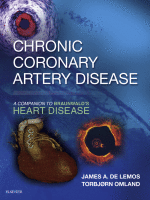Physical Address
304 North Cardinal St.
Dorchester Center, MA 02124

Introduction The 12-lead electrocardiogram (ECG) has remained the standard initial evaluation tool in patients with suspected or known ischemic and electrophysiologic cardiac conditions for more than half a century. With the first description of the string galvanometer by Einthoven in…

Introduction Several diagnostic tools exist to clinically assess the prevalence and severity of coronary heart disease and to enhance the ability to identify the “vulnerable” patient at risk of developing cardiovascular events. In addition, the assessment of biomarkers is one…

Introduction Atheromatous plaque in arterial wall is the pathologic substrate for myocardial infarction and ischemic stroke and is intimately related to the deposition of oxidized lipids from the circulation into the subintimal space, initiating a vicious cycle of local inflammation,…

Introduction Despite continuing technological advances in cardiovascular medicine, the history and physical examination remain vital to establish an accurate diagnosis of chronic coronary artery disease (CAD). Whereas many patients may describe typical angina, providers cannot rely on these symptoms alone…

Introduction Myocardial ischemia occurs when the ability to supply oxygen and nutrients to the myocardium is exceeded by the myocardium’s oxygen and nutrient requirements. The heart is primarily an aerobic organ and has a narrow threshold for a deficit in…

Introduction Atherosclerotic disease of the epicardial coronary arteries has been recognized as the cause of angina pectoris for more than 2 centuries, and sudden thrombotic occlusion of an epicardial coronary artery has been well established as the cause of acute…

Introduction Atherosclerosis is a chronic inflammatory process triggered by accumulation of cholesterol-containing low-density lipoprotein (LDL) particles in the arterial wall. Major etiologic factors include hyperlipidemia, hypertension, diabetes, and cigarette smoking, all of which are thought to initiate and promote vascular…

Introduction This chapter reviews current understanding of the genetic architecture of coronary atherosclerosis as gleaned from Mendelian and common, complex forms of the disease. Newly identified pathways and biologic mechanisms are highlighted before discussing the present and future role of…

Introduction Cardiovascular disease (CVD) and specifically ischemic heart disease (IHD) have long been the leading cause of death in high-income countries (HICs); indeed, “disease of the heart,” in all its manifestations, has topped the Centers for Disease Control and Prevention…

Introduction Coronary artery disease (CAD) is a major cause of death and disability in developed countries. Although CAD mortality rates worldwide have declined over the past 4 decades, CAD remains responsible for approximately one-third or more of all deaths in…